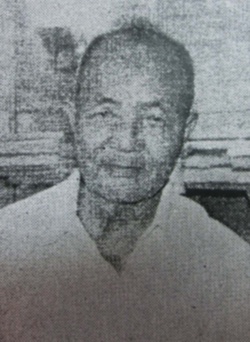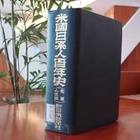Florida, located in the southeastern part of the United States, between the Gulf of Mexico and the Atlantic Ocean and jutting out into the Caribbean Sea, is one of the states farthest from Japan, but there are surprisingly many Japanese people who have made their mark there, and the "Centennial History" introduces the state over about 10 pages.
"Japanese people began immigrating to the state after the Florida East Coast Railroad was built from Jacksonville to Miami in 1896. At the time, the state was covered with swamps and transportation was extremely poor. As a result, the population was sparse, but with the opening of the railroad, the state became famous overnight, attracting businessmen and, in winter, wealthy travelers."
According to statistics, there was only one Japanese person in Florida in 1900. The number gradually increased to 50 in 1910, 106 in 1920, 153 in 1930, 154 in 1940, and 238 in 1950, before suddenly reaching 1,315 in 1960.
The Yamato Colony settlement project
The first Japanese to set foot in this state are said to have been Japanese who attempted settlement projects following the development of the Florida East Course Railroad. "Masakuni Okudaira, the younger brother of the lord of Nakatsu in Kyushu, and Jo Sakai (from Miyazu, Kyoto) both came to the state after hearing about the plan while studying in New York."
It is thought that before this, there were Japanese people from New York and Chicago who lived in Miami as house servants for wealthy people, but there are no records of this.
The settlement project, which was led by Okudaira, Sakai, and others, included Japanese people living in the New York area and people from all over Japan, and led to the formation of a village called Yamato Colony. The background and outcome of this project are summarized here.
"Okudaira, one of the pioneers who settled here as early as 1904, purchased 80 British Canadians, while Sakai purchased 40 British Canadians, which they named Yamato Colony. The railroad station was also called "Yamato" until much later. Sakai, at the recommendation of the railroad company's vice president, Ingraham, returned to Japan temporarily to expand his business, and returned to the United States from his hometown of Miyazu, accompanied by his younger brother, Kamiya Tamemasu, Oki, Tsujii, and about a dozen others. Two years later, Morikami Sukeji, Yamauchi Jinzo, and in 1907 Kobayashi Hideo (all current residents) followed them to the United States and settled in this new frontier land."
After this, the colony saw an increase in interest in emigrating to Florida, and at its peak around 1910, the population exceeded 100. At first, pineapples were grown, but they were no longer competitive with cheaper Cuban pineapples, so tomatoes, peppers, eggplants, and other crops were grown instead, and these were shipped to New York, Chicago, Denver, and as far away as the West Coast.
Some of the settlers came as married couples, and children were born to them.
Although vegetable production was quite successful for a time during the severe cold spells in other states, a land boom occurred in Florida, and some farmers gave up on farming in the harsh weather conditions, abandoning their land and moving to other states or returning home.
"Then in 1925, what is now Miami Beach opened up, and a huge land boom occurred. Land that had been bought for next to nothing went up in price by a thousand dollars in the morning, two thousand dollars in the evening, three thousand dollars the next morning, and four thousand dollars the following night. Most of the Japanese who owned land sold it and returned to their home countries or moved to other states. Gradually, the number of Japanese people decreased, and after that, the Yamato Colony did not do well as an agricultural colony. As the colony became urbanized, many people changed their occupation..."
Pioneer, Sukeji Morikami
At the time "Centennial History" was compiled, only one family was living at the site of the colony. Another person who moved out of the colony and continued farming until the end was Morikami Sukeji (George Morikami). He later donated land to the local area, which led to the creation of a park including a Japanese garden. This book provides a detailed introduction to Morikami.
Born in Miyazu, Kyoto Prefecture, he traveled to the United States in 1906 and joined the colony, attending public schools and learning English along the way, and succeeding not only in farming but also in the brokerage business. While farming, he gradually purchased land, and as land prices rose over time, he amassed a large fortune.
Although the business was successful, he continued to live alone and led an extremely frugal lifestyle.
"Even now, their lives are almost the same as they were in the pioneer days, living in old houses on the former Japanese villages, sometimes in hotels, or trailers, content with an extremely simple and frugal lifestyle.... Though they may seem eccentric to the world, they are well understood by the older residents..."
Morikami also donated hundreds of thousands of yen to the construction of a new elementary school in his hometown.
There are several anecdotes about the development of Florida, a tropical and subtropical climate with swamps and wilderness. There are stories about how hordes of mosquitoes were so terrifying that people could not see in front of them, cows had their mouths filled with mosquitoes and suffocated to death, and horses had their blood sucked so badly that they ran for their lives.
Also, before the war, there was a Japanese man named Oyama in Daytona Beach on the mid-Atlantic coast who had his eye on what was then a fishing village, and put on a ghost story in an attempt to buy the land cheaply.
"Every night, he would appear in various parts of the land dressed as a ghost, and when rumors about him spread and he could no longer find buyers, he bought them all up for next to nothing. Before the war, there was an area in this town called the Oyama Block, which was lined with over twenty stores, and by all accounts he became a millionaire. However, as success comes with many obstacles, he later married an American woman who was after his money, which was bad luck for him. He was photographed with another woman in a set-up, his assets stolen, and he left penniless as before."
In addition to Yamato Colony, a colony was planned by Japanese people at Middle Hawk in Clay County, where a group of Japanese people from California settled in 1913 and attempted to cultivate vegetables. However, problems with the quality of the land and poor transportation meant that the colony was soon dissolved.
Other areas where Japanese people have been active in the state include the Miami area and St. Petersburg on the Gulf Coast. In Miami, a Japanese man named Miyanaga is said to have been a pioneer, opening a Japanese art store around 1905.
In St. Petersburg, Japanese general stores began appearing around 1922, and around 1930 a Western restaurant called Nikko Inn was opened. A Japanese Association was also organized, but it was dissolved when war broke out between Japan and the United States.
Contributed to the development of Miami Beach
Two Japanese men are noted for their contributions to the development of Miami Beach, east of Miami. Juzo Tashiro and Kotaro Sudo, both from Kanagawa Prefecture, began working for the famous businessman Karl Fischer in 1916, and were involved in the development of what was then just wilderness and wetlands. Both men later became independent, running successful tree nurseries and other businesses that contributed greatly to the local community. The Centennial History places their achievements second only to Morikami.
There was a unique Japanese woman who was introduced as the "100-year-old Dr. Sudo."
"In St. Cloud City, Miss Sudo, originally from Hirosaki City, Aomori Prefecture, is 100 years old this year and is the first female doctor in the United States. She came to the United States in 1891, studied in the eastern part of the country, became a doctor and visited Japan many times. Since coming to the United States in 1907, she has lived in Florida. At that time, she brought along her younger brother Narita and his family, and adopted all five of his children, living with Yoshida Gengoro, who married her eldest daughter Jean, and her other children have started families all over the United States."
(Note: I have used the original text as much as possible, but have made some edits. Titles have been omitted.)
*In the next (final) episode, we will introduce " Japanese Americans in the Southern Coastal States ."
© 2015 Ryusuke Kawai







